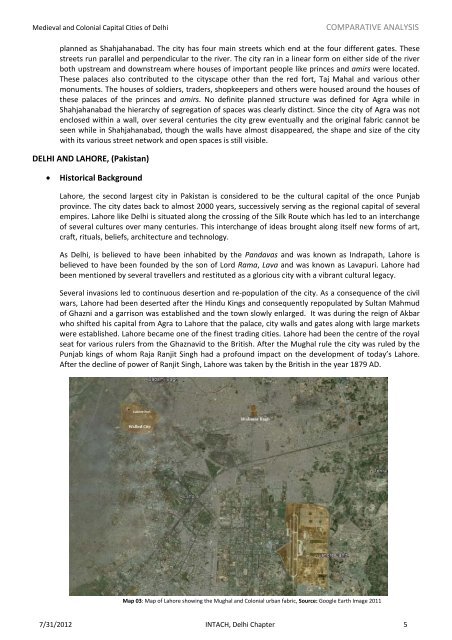Medieval and Colonial Capital Cities of <strong>Delhi</strong>COMPARATIVE ANALYSISplanned as Shahjahanabad. The city has four main streets which end at the four different gates. Thesestreets run parallel and perpendicular to the river. The city ran in a linear form on either side of the riverboth upstream and downstream where houses of important people like princes and amirs were located.These palaces also contributed to the cityscape other than the red fort, Taj Mahal and various othermonuments. The houses of soldiers, traders, shopkeepers and others were housed around the houses ofthese palaces of the princes and amirs. No definite planned structure was defined for Agra while inShahjahanabad the hierarchy of segregation of spaces was clearly distinct. Since the city of Agra was notenclosed within a wall, over several centuries the city grew eventually and the original fabric cannot beseen while in Shahjahanabad, though the walls have almost disappeared, the shape and size of the citywith its various street network and open spaces is still visible.DELHI AND LAHORE, (Pakistan)• Historical BackgroundLahore, the second largest city in Pakistan is considered to be the cultural capital of the once Punjabprovince. The city dates back to almost 2000 years, successively serving as the regional capital of severalempires. Lahore like <strong>Delhi</strong> is situated along the crossing of the Silk Route which has led to an interchangeof several cultures over many centuries. This interchange of ideas brought along itself new forms of art,craft, rituals, beliefs, architecture and technology.As <strong>Delhi</strong>, is believed to have been inhabited by the Pandavas and was known as Indrapath, Lahore isbelieved to have been founded by the son of Lord Rama, Lava and was known as Lavapuri. Lahore hadbeen mentioned by several travellers and restituted as a glorious city with a vibrant cultural legacy.Several invasions led to continuous desertion and re‐population of the city. As a consequence of the civilwars, Lahore had been deserted after the Hindu Kings and consequently repopulated by Sultan Mahmudof Ghazni and a garrison was established and the town slowly enlarged. It was during the reign of Akbarwho shifted his capital from Agra to Lahore that the palace, city walls and gates along with large marketswere established. Lahore became one of the finest trading cities. Lahore had been the centre of the royalseat for various rulers from the Ghaznavid to the British. After the Mughal rule the city was ruled by thePunjab kings of whom Raja Ranjit Singh had a profound impact on the development of today’s Lahore.After the decline of power of Ranjit Singh, Lahore was taken by the British in the year 1879 AD.Map 03: Map of Lahore showing the Mughal and Colonial urban fabric, Source: Google Earth Image 20117/31/2012 INTACH, <strong>Delhi</strong> Chapter 5
Medieval and Colonial Capital Cities of <strong>Delhi</strong>COMPARATIVE ANALYSISThe glory and the location of the city were first mentionedby Ptolemy in 2nd cen. AD and again by the Chinese travellerHieun Tsang in 7th cen. AD. The city is profusely marked byvarious architectural elements which mark its urban fabricdefining the character of the town and its planning. TheWalled city consisting of the fort built by Akbar and thecantonment area designed by the British are two of thedistinct characters of planning.• Status of nominationLahore is not nominated under the UNESCO’s list ofWorld <strong>Heritage</strong> Cities.• Architectural componentsPic 04: Marble pavilion and old entrance of theLahore fort, by Craddock, James, 1860‐1870,Source: Victoria and Albert MuseumThe architectural heritage of Lahore reflects highest degree of human intervention achieved during theMughal rule which continued to develop even after the decline of Mughal rule. The Lahore Fort and theShalamar Gardens are two such examples which define the achievements of exceptional architecturalcreativity in terms of usage of materials and monumental technology.The Fort and the Shalamar Garden has been inscribed in UNESCO’s list of world heritage sites in 1981under the criteria (i) (ii) and (iii).The inscribed property includes two distinct royal complexes, the Lahore Fort and the Shalimar Gardens,both located in the <strong>City</strong> of Lahore. The two complexes – onecharacterized by monumental structures and the other byextensive water gardens ‐ are outstanding examples ofMughal artistic expression at its height, as it evolved duringthe 16th and 17th centuries.The Lahore Fort, situated in the north‐west corner of theWalled <strong>City</strong> of Lahore, occupies a site which has beenPic 05: Badshahi Mosque, Source: Nominationoccupied for several millenia. Assuming its presentconfiguration during the 11th century, the Fort was destroyed and rebuilt several times by the earlyMughals during the 13th to the 15th centuries. The 21 monuments which survive within its boundariescomprise an outstanding repertory of the forms of Mughal architecture from the reign of Akbar (1542‐1605), characterized by standardized masonry of baked brick and red sandstone courses relieved byHindu motifs, through that of Shah Jahan (1627‐58), characterized by the use of luxurious marbles, inlaysof precious materials and mosaics, set within exuberant decorative motifs of Persian origins. Akbar’sefforts are exemplified in the Masjidi Gate flanked by two bastions and the Khana‐e‐Khas‐o‐Am (Publicand Private Audience Hall). Akbar’s successor, Jahangir, finished the large north court (1617‐18) begun byAkbar and, in 1624‐25, decorated the north and north‐west walls of the Fort. Shah Jahan added a fairytale‐like complex of buildings surrounding the Court of Shah Jahan (Diwan‐e‐Kas, Lal Burj, Khwabgah‐e‐Jahangiri, and the Shish Mahal, 1631‐32, one of the most beautiful palaces in the world, sparkling withmosaics of glass, gilt, semi‐precious stones and marble screening).The Shalimar Gardens, constructed by Shah Jahan in 1641‐2 isa Mughal garden, layering Persian influences over medievalIslamic garden traditions, and bearing witness to the apogeeof Mughal artistic expression. The Mughal garden ischaracterized by enclosing walls, a rectilinear layout of pathsand features, and large expanses of flowing water. TheShalimar Gardens cover 16 hectares, and is arranged in threeterraces descending from the south to the north. The regularplan, enclosed by a crenellated wall of red sandstone,disposes square beds on the upper and lower terraces andelongated blocks on the narrower, intermediate terrace;7/31/2012 INTACH, <strong>Delhi</strong> Chapter 6Pic 06: Art and Craft of Lahore‐Intangible <strong>Heritage</strong>Source: Victoria and Albert Museum















